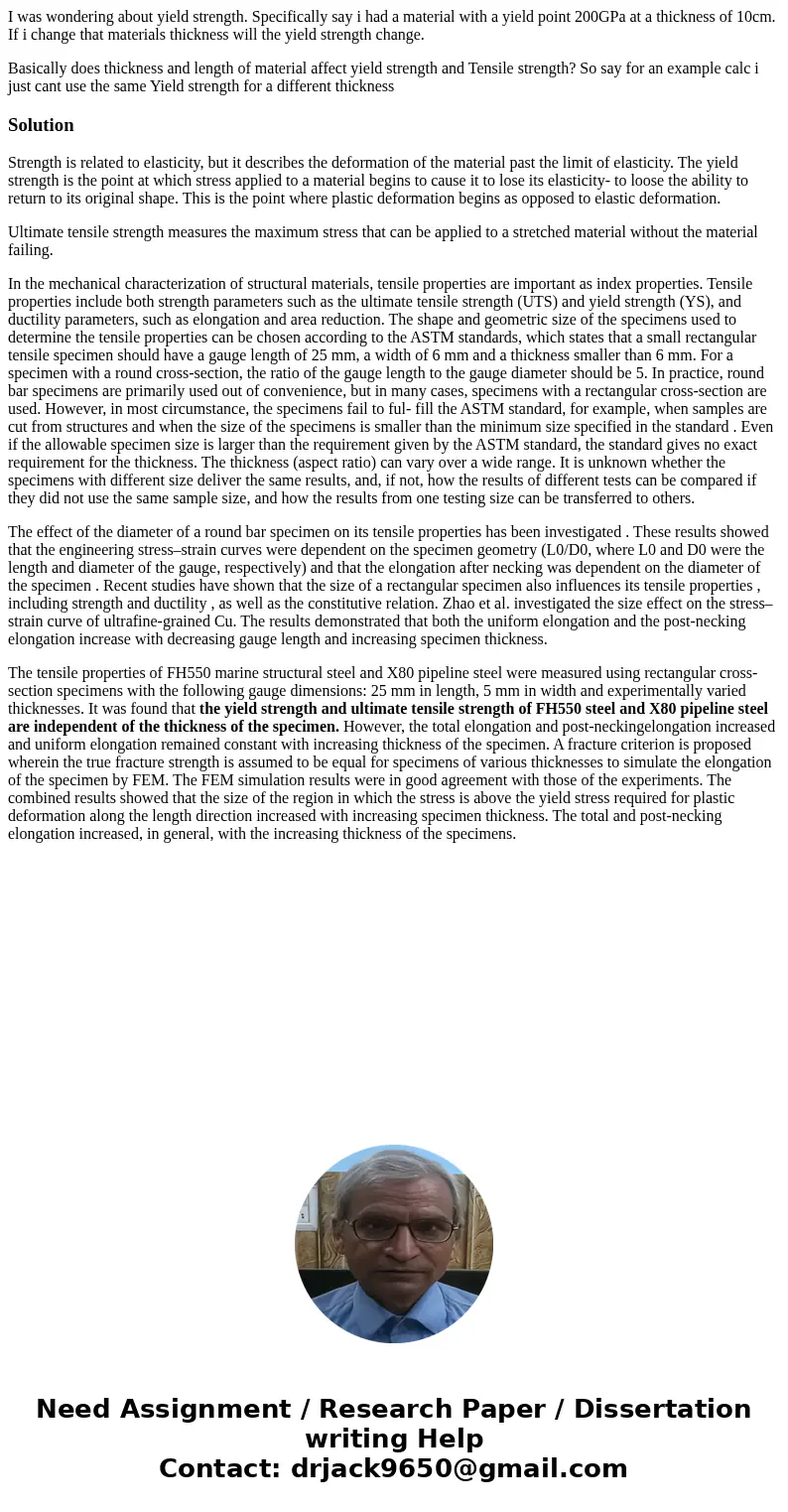I was wondering about yield strength Specifically say i had
I was wondering about yield strength. Specifically say i had a material with a yield point 200GPa at a thickness of 10cm. If i change that materials thickness will the yield strength change.
Basically does thickness and length of material affect yield strength and Tensile strength? So say for an example calc i just cant use the same Yield strength for a different thickness
Solution
Strength is related to elasticity, but it describes the deformation of the material past the limit of elasticity. The yield strength is the point at which stress applied to a material begins to cause it to lose its elasticity- to loose the ability to return to its original shape. This is the point where plastic deformation begins as opposed to elastic deformation.
Ultimate tensile strength measures the maximum stress that can be applied to a stretched material without the material failing.
In the mechanical characterization of structural materials, tensile properties are important as index properties. Tensile properties include both strength parameters such as the ultimate tensile strength (UTS) and yield strength (YS), and ductility parameters, such as elongation and area reduction. The shape and geometric size of the specimens used to determine the tensile properties can be chosen according to the ASTM standards, which states that a small rectangular tensile specimen should have a gauge length of 25 mm, a width of 6 mm and a thickness smaller than 6 mm. For a specimen with a round cross-section, the ratio of the gauge length to the gauge diameter should be 5. In practice, round bar specimens are primarily used out of convenience, but in many cases, specimens with a rectangular cross-section are used. However, in most circumstance, the specimens fail to ful- fill the ASTM standard, for example, when samples are cut from structures and when the size of the specimens is smaller than the minimum size specified in the standard . Even if the allowable specimen size is larger than the requirement given by the ASTM standard, the standard gives no exact requirement for the thickness. The thickness (aspect ratio) can vary over a wide range. It is unknown whether the specimens with different size deliver the same results, and, if not, how the results of different tests can be compared if they did not use the same sample size, and how the results from one testing size can be transferred to others.
The effect of the diameter of a round bar specimen on its tensile properties has been investigated . These results showed that the engineering stress–strain curves were dependent on the specimen geometry (L0/D0, where L0 and D0 were the length and diameter of the gauge, respectively) and that the elongation after necking was dependent on the diameter of the specimen . Recent studies have shown that the size of a rectangular specimen also influences its tensile properties , including strength and ductility , as well as the constitutive relation. Zhao et al. investigated the size effect on the stress–strain curve of ultrafine-grained Cu. The results demonstrated that both the uniform elongation and the post-necking elongation increase with decreasing gauge length and increasing specimen thickness.
The tensile properties of FH550 marine structural steel and X80 pipeline steel were measured using rectangular cross-section specimens with the following gauge dimensions: 25 mm in length, 5 mm in width and experimentally varied thicknesses. It was found that the yield strength and ultimate tensile strength of FH550 steel and X80 pipeline steel are independent of the thickness of the specimen. However, the total elongation and post-neckingelongation increased and uniform elongation remained constant with increasing thickness of the specimen. A fracture criterion is proposed wherein the true fracture strength is assumed to be equal for specimens of various thicknesses to simulate the elongation of the specimen by FEM. The FEM simulation results were in good agreement with those of the experiments. The combined results showed that the size of the region in which the stress is above the yield stress required for plastic deformation along the length direction increased with increasing specimen thickness. The total and post-necking elongation increased, in general, with the increasing thickness of the specimens.

 Homework Sourse
Homework Sourse